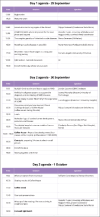Empowering clinicians with artificial intelligence in hereditary neuromuscular disorders
- PMID: 40626680
- PMCID: PMC12250589
- DOI: 10.36185/2532-1900-927
Empowering clinicians with artificial intelligence in hereditary neuromuscular disorders
Abstract
Artificial Intelligence (AI) is the ability of machines to perform tasks that typically require human intelligence, such as learning, problem-solving, and decision-making. Its integration into healthcare may revolutionize many areas of medicine, including the diagnosis and management of neuromuscular disorders (NMDs).
These disorders, characterized by their clinical and genetical complexity and heterogeneity, demand innovative approaches to improve patient outcomes. Among these approaches, AI-driven solutions hold immense potential. However, the success of these solutions depends on preparing a new generation of clinicians equipped to harness the multifaceted power of AI.
One remarkable initiative addressing this need is the CoMPaSS-NMD project, which pioneers an interdisciplinary framework for developing AI-driven strategies to stratify patients using multiple clinical, histopathological, MRI e genetic datasets. By fostering a shared working language and integrating diverse competencies, the project aims to advance knowledge dissemination and bridge gaps between traditional disciplines. This approach is vital for addressing the challenges posed by NMDs, where early diagnosis and personalized treatment plans are critical.
To support this mission, the Young Investigator Training (YIT) initiative within CoMPaSS-NMD fosters education and scientific exchange among early-career researchers. By promoting high-quality clinical assessments and multidisciplinary training, YIT prepares a new generation to meet the evolving challenges in NMD care and research.
Keywords: MRI; artificial intelligence; genetics; histology; neuromuscular disorders.
Copyright © 2025 Gaetano Conte Academy - Mediterranean Society of Myology.
Conflict of interest statement
The authors declare no conflict of interest.
Figures
References
-
- Schoser B. Editorial:Framing artificial intelligence to neuromuscular disorders. Curr Opin Neurol. 2023. Oct 1;36(5):424-426. https://doi.org/10.1097/WCO.0000000000001190. PMID: 37678338 10.1097/WCO.0000000000001190 - DOI - PubMed
-
- Benarroch L, Bonne G, Rivier F, et al. The 2024 version of the gene table of neuromuscular disorders (nuclear genome). Neuromuscul Disord. 2024;34:126-170. https://doi.org/10.1016/j.nmd.2023.12.007. Epub 2023 Dec 14. PMID: 38253411. 10.1016/j.nmd.2023.12.007 - DOI - PubMed
-
- Computational Models for New Patient Stratification Strategies of Neuromuscular Disorders (CoMPaSS-NMD) Horizon2020 Project-ID 101080874, https://compass-nmd.eu/
-
- Warman Chardon J, Díaz-Manera J, Tasca G, et al. MYO-MRI diagnostic protocols in genetic myopathies. Neuromuscul Disord. 2019;29(11):827-841. https://doi.org/10.1016/j.nmd.2019.08.011. Epub 2019 Sep 16. PMID: 31727541. 10.1016/j.nmd.2019.08.011 - DOI - PubMed
MeSH terms
LinkOut - more resources
Full Text Sources
Medical



